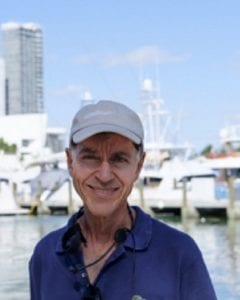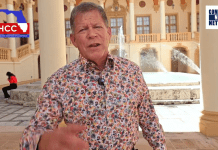Al Capone’s frenzied schedule took him away from his posh Palm Island home in 1929 to a crime conference in Atlantic City, New Jersey, a convocation attended by America’s most fearsome organized crime figures. Attendees included Frank Costello, Meyer Lansky, Charles “Lucky” Luciano and Dutch Schultz, among others. On his way to Chicago afterwards, police arrested Capone on a hidden weapons charge during a Philadelphia stopover. Tried and convicted on this charge, the gangster received a one year sentence in Philadelphia’s Eastern State Penitentiary, marking the first time he had suffered incarceration.
Such was Capone’s celebrity that when the date of his release became known, an estimated 500 persons stood outside the prison to gain a glimpse of him. But wily prison officials transferred the crime lord to another prison the day before his release date to avoid a potentially chaotic scene outside of the prison. A week later, Time magazine featured a smiling Capone on its cover.
Soon, however, Al was confronted by a series of attempts to prevent his return to Palm Island. In 1930, Florida governor Doyle E. Carlton expressed his determination to keep Capone from reentering the Sunshine State. After that gambit failed, Capone’s Palm Island home was raided by the sheriff of Dade County and the police chief of Miami Beach. Subsequent efforts to keep Capone away from his home came to naught, especially after he hired two young, capable attorneys, Vincent Giblin and James “Fritz” Gordon, to represent him.
The duo rescued Al from several legal impasses, as local authorities twice arrested him while he was enjoying boxing matches in and around downtown Miami. The Miami City Commission, in 1930, passed a vagrancy law of dubious constitutionality aimed “squarely” at him. The ordinance made it unlawful for persons considered dangerous to public safety, as well as persons known to be crooks, gangsters or hijackers to come within the city limits of Miami. Capone’s attorneys fileted this ordinance on the few occasions it was implemented. Another unsuccessful attempt to limit the activities of the gangster centered on padlocking his home to keep him away from it.
The closest Capone came to a serious legal problem was when he was brought before the court in downtown Miami’s towering Dade County Courthouse, in 1930, to address perjury charges for statements he made while under oath for earlier attempts by city officials to imprison him. Ultimately, a weak prosecution case led the Dade County Solicitor to drop all charges.
Capone sometimes took the offensive against his adversaries. On one occasion, he sent a lieutenant to the Miami News Tower to meet with James Cox, owner and publisher of the Miami Daily News, a frequent critic of the gangster. The meeting was short-lived as Cox quickly rejected the intermediary’s offer to purchase the newspaper for $5 million. On another occasion, Capone presented Roddy Burdine, dubbed the “Merchant Prince,” for his prowess as a merchandising whiz for his namesake department store, a check for $1,000 for the Community Chest, the predecessor of today’s United Way. With Capone’s largesse came the request that Roddy “arrange a little party” for Al at his country club. When Burdine presented the check to Community Chest officials, they rejected it and instructed him to return it to the gangster.
Scarface’s luck ran out in 1931, when he was found guilty of income tax evasion and sentenced to ten years in federal prison. Capone spent his first two years of incarceration in Atlanta’s federal prison before his removal to a new facility on Alcatraz Island in San Francisco Bay. He was released from the fearsome Alcatraz prison in 1939 as his health was deteriorating, the result of tertiary syphilis. After receiving treatment on the east coast of the U.S., the crime boss returned to his home in Miami Beach in 1940.
Unlike his earlier stay on Palm Island, the seven years Capone spent there in the 1940s were uneventful. The ailing gangster now shared his mansion with his wife Mae and son, Sonny, as well as Mae’s brother and sister-in law. Al’s wealth was diminished at this point and his life achieved a certain predictability, a far cry from the days when he was a free spender with a swagger. He spent long days seated in a lawn chair by his swimming pool, where he often dozed off; he played cards with old buddies; and fished off his pier behind his home. Occasionally, Capone’s mental acuity and energy level heightened, prompting a visit to a local nightclub or a restaurant for dinner. At other times, he threw a party featuring food, drinks, and even a small musical combo in his Palm Island home.

In January 1947, shortly after celebrating his forty-eighth birthday, Capone suffered a massive stroke. Four days later, he was dead. Capone’s body was taken to Chicago for burial after services in St. Patrick’s Catholic Church on Miami Beach. While the crime kingpin was gone, the stories, interest, and even legends about his brief but eventful life have only grown in the more than seven decades since his passing. Nowhere is this interest more intense than in the Miami area.
Paul S. George, Ph.D., serves as Resident Historian, HistoryMiami Museum. He conducts history tours throughout the County and even beyond for HistoryMiami. Dr. George also leads Little Havana tours as part of Viernes Culturales, a monthly celebration, held every third Friday, of the culture and history of that quarter.






